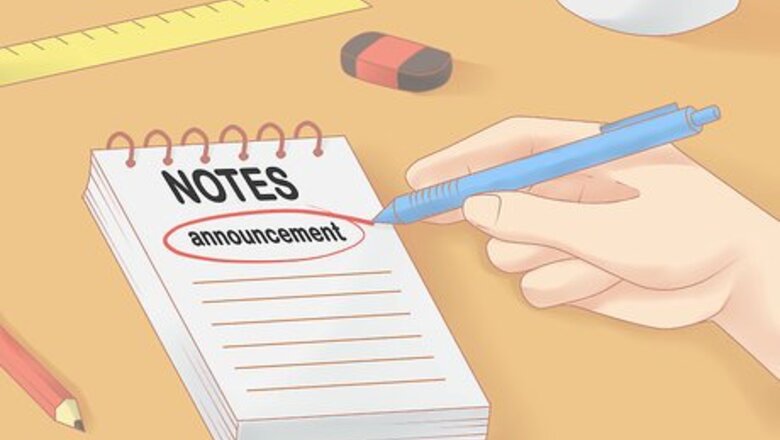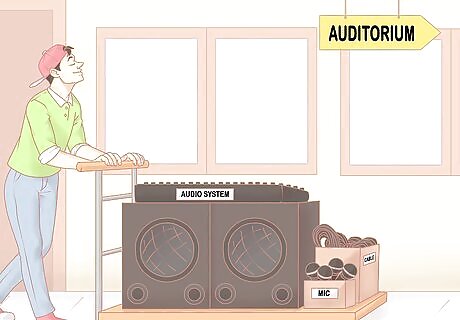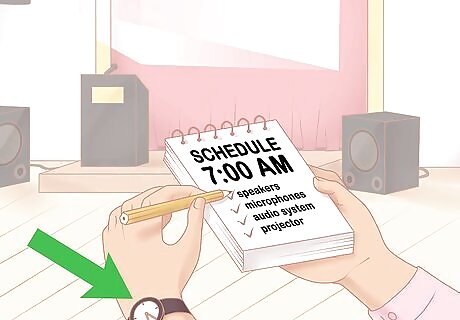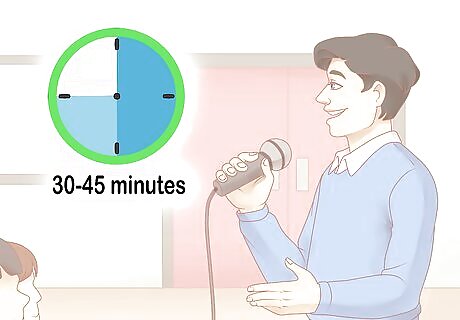
views
X
Trustworthy Source
Edutopia
Educational nonprofit organization focused on encouraging and celebrating classroom innovation
Go to source
Creating an Agenda for your Assembly

Outline any topics or announcements that need to be addressed. Make sure you’re sharing relevant and useful information during the assembly. If this assembly is to go over a specific topic like an event or field trip, make sure that’s the focus of the agenda. If this is a daily assembly, see if there are any routines like saying the Pledge of Allegiance or celebrating birthdays. Some examples of daily agenda items include: birthdays, lunch menu, awards, student of the day/week, weather, after-school activities, and rehearsals or team practices.

Speak with any faculty members that may have information to share. If the assembly or any agenda items pertaining to a particular department, make sure the appropriate faculty members are prepared to handle any questions the students may have. For example, if you mention a field trip, make sure the appropriate teachers are prepared to hand out permission slips after the meeting.

Prepare any technical or audio/visual equipment in advance. If you need a microphone, speakers or a display, set it up before the meeting and make sure it’s functioning. Primary school children can be incredibly talkative, so a microphone might be better for projection than your plain voice. If you need to show any videos or media, make sure you have the right files queued up and ready to play so you don’t lose students’ interest.
Running an Assembly

Arrive early and check any A/V equipment. You’ll want your students to pay attention as soon as they enter the assembly space. Make sure you’re standing at the podium and ready to get going once everyone enters. Make sure you have a copy of your agenda with you. If any forms or handouts are needed for the assembly, make sure the appropriate faculty members have their supplies.

Ask other faculty members to look out for any restless students. Fidgety students can distract others from listening, so it can be a good idea to have other faculty members keep an eye out for students who may need extra help paying attention. Ask these faculty members to sit amongst students so they can easily step in if a student is being disruptive.

Stick to your agenda items and don’t allow for distractions. Children in this age group can lose focus easily, so don’t get sidetracked. Don’t allow “fun” announcements like awards or birthdays to overshadow important details. If students have questions, make time for them at the end of the meeting. It may also be helpful to hold designated office hours for students to ask questions if the assembly covers a particularly difficult topic.

Be positive, energetic, and loud. Children in this age group respond well to positive reinforcement and energy. Reward students in order to encourage good behaviors. Think of yourself as a friendly face, welcoming your students to their day. Examples of student rewards can include: student of the day/week, a student talent spotlight, a good samaritan award or recognition for athletic and academic achievements.
Making Assemblies Fun for Primary Students

Keep it short and to the point. Primary students aren't known for their long attention spans, so try to keep your assembly between 30-45 minutes to ensure they stay engaged. If your assembly is for a special topic and requires more time, consider allowing students to take a bathroom break or give them time during the assembly to get up and stretch.

Encourage participation with performances or demonstrations. Let your students showcase a talent or skill to keep your assembly engaging. Beyond rewarding students, allowing them to take part in the assembly can keep attitudes positive and energy high. You could spotlight a certain class or let a student read certain announcements. If there’s a school play, you could allow the cast to perform a scene. If a school team won a championship, you could use the assembly to present the award. These are positive ways to engage students in the extracurricular activities that inspire them.

Create educational themes for each meeting. Themes can help students stay interested and retain information. Perhaps you want to use a holiday or special event as a theme for your agenda. This could be as simple as encouraging students to wear hats during assembly on “National Hat Day” or having special guest speakers present to students.

Create fun rituals students can grow accustomed to. Continuous change can be difficult for this age group, so make sure your agenda follows a pattern students can follow. At the same time, too much routine can bore this demographic, so try to include fun daily rituals. For example, you could share a daily historical fact. If you have a school creed or song, reciting it daily may be fun for students.



















Comments
0 comment